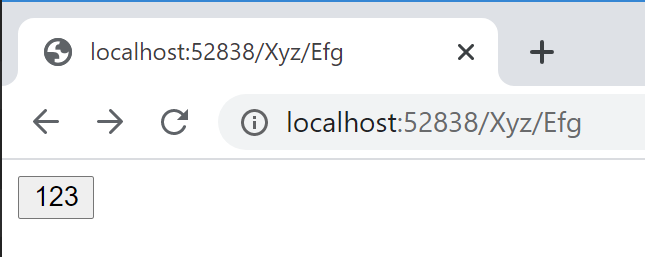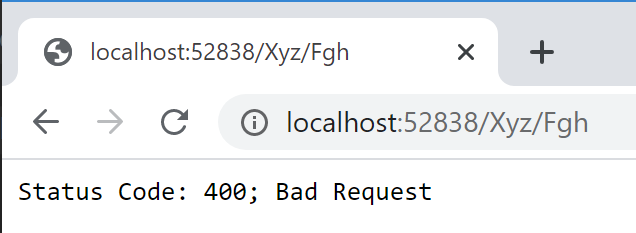Programmatically generating request verification token
Starting with an empty MVC project, here's my Startup.cs:
using Microsoft.AspNetCore.Builder;
using Microsoft.AspNetCore.Hosting;
using Microsoft.Extensions.DependencyInjection;
namespace AntiForgeryExample
{
public class Startup
{
public void ConfigureServices(IServiceCollection services)
{
services.AddMvc();
}
public void Configure(IApplicationBuilder app, IWebHostEnvironment env)
{
app.UseDeveloperExceptionPage();
app.UseStatusCodePages();
app.UseRouting();
app.UseEndpoints(endpoints =>
{
endpoints.MapDefaultControllerRoute();
});
}
}
}
And here's my HomeController.cs:
using Microsoft.AspNetCore.Mvc;
using System.Net;
namespace AntiForgeryExample
{
public class XyzController : Controller
{
[HttpPost]
[ValidateAntiForgeryToken]
public string Fgh() => "fgh 1";
[HttpGet]
public ContentResult Efg()
{
return new ContentResult()
{
ContentType = "text/html",
StatusCode = (int)HttpStatusCode.OK,
Content = @"<!DOCTYPE html>
<html>
<body>
<form method=""post"" action=""/Xyz/Fgh"">
<button type=""submit"">123</Button>
</form>
</body>
</html>"
};
}
}
}
The following line in Startup.cs adds the anti-forgery middleware:
services.AddMvc();
So, if we go to http://localhost:52838/Xyz/Efg, we get the simple page with a single button:
If we press the button, we get a 400 "Bad Request" response:
I'm assuming this is because we haven't passed a valid request verification token as part of the post. The Fgh method has the ValidateAntiForgeryToken attribute applied:
[HttpPost]
[ValidateAntiForgeryToken]
public string Fgh() => "fgh 1";
Thus a token is required when calling this method.
As described on this page, normally the code for this token will automatically be included if you use the form tag helper with ASP.NET Core MVC or a Razor Page. It will look something like this and be included as part of the form tag:
<input name="__RequestVerificationToken" type="hidden" value="CfDJ8NrAkS ... s2-m9Yw">
In the example program I show above, we're programmatically generating the HTML with the form.
My question is, is there a way to programmatically generate the required token from C#, without having to go through using an MVC view or Razor Page. The idea would be that we'd get the token value and then include the input tag:
<input name="__RequestVerificationToken" type="hidden" value="TOKEN VALUE HERE">
I shared this question on the /r/dotnet subreddit.
/u/kenos1 provided a very helpful answer there:
You can inject Microsoft.AspNetCore.Antiforgery.IAntiforgery and call GetTokens() on it.
Here’s the documentation: link
As he mentions there, we inject IAntiforgery at the XyzController constructor:
private IAntiforgery antiforgery;
public XyzController(IAntiforgery antiforgery_)
{
antiforgery = antiforgery_;
}
We call GetAndStoreTokens on the IAntiforgery instance that we injected:
var token_set = antiforgery.GetAndStoreTokens(HttpContext);
And finally, we use the resulting token in the generated HTML:
return new ContentResult()
{
ContentType = "text/html",
StatusCode = (int)HttpStatusCode.OK,
Content = string.Format(@"<!DOCTYPE html>
<html>
<body>
<form method=""post"" action=""/Xyz/Fgh"">
<button type=""submit"">123</Button>
<input name=""__RequestVerificationToken"" type=""hidden"" value=""{0}"">
</form>
</body>
</html>",
token_set.RequestToken)
};
Here is the controller file in its entirety:
using Microsoft.AspNetCore.Antiforgery;
using Microsoft.AspNetCore.Mvc;
using Microsoft.AspNetCore.Mvc.Rendering;
using Microsoft.AspNetCore.Mvc.ViewFeatures;
using System.Net;
namespace AntiForgeryExample
{
public class XyzController : Controller
{
private IAntiforgery antiforgery;
public XyzController(IAntiforgery antiforgery_)
{
antiforgery = antiforgery_;
}
[HttpPost]
[ValidateAntiForgeryToken]
public string Fgh() => "fgh 1";
[HttpGet]
public ContentResult Efg()
{
var token_set = antiforgery.GetAndStoreTokens(HttpContext);
return new ContentResult()
{
ContentType = "text/html",
StatusCode = (int)HttpStatusCode.OK,
Content = string.Format(@"<!DOCTYPE html>
<html>
<body>
<form method=""post"" action=""/Xyz/Fgh"">
<button type=""submit"">123</Button>
<input name=""__RequestVerificationToken"" type=""hidden"" value=""{0}"">
</form>
</body>
</html>",
token_set.RequestToken)
};
}
}
}
The official ASP.NET Core 3.1 documentation mentions the GetAndStoreTokens method here.
- How to disable the component hierarchy in Blazor?
- IdentityServer4 in IIS being recycled due to app_offline.htm when using discovery endpoint sometimes
- Interact with the Virtualize component
- Cannot resolve scoped service 'xx.IEnumerable`1[xx.IDbContextOptionsConfiguration`1[xx.ExampleDbContext]]...' after upgrading from .NET 8 to .NET 9
- How i can add endpoint (or сatch a request and check its path) to BCL?
- How does the "Microsoft.AspNetCore.Diagnostics.EntityFrameworkCore" package resolves types which are in "Microsoft.AspNetCore.dll"?
- Customize output Serilog
- Unhandled exception. System.InvalidOperationException
- Is it possible to use ASP.NET Core within an F# fsx script?
- How to send data with the size more than Signalr message size limit in Blazor?
- IDX12723: Unable to decode the payload '[PII of type 'System.String' is hidden
- UpdateRange method of Entity Framework Core does not work
- How to enable CORS in ASP.net Core WebAPI
- Why does my CORS configuration still block datatables from consuming an API?
- .NET return JSON without reformating
- .NET 8 & SQL Server 2016 - Contains() throws error
- Multiple many-to-many and multiple one-to-one relationships in the same entities
- Unable to Select Custom User Class in Identity Scaffolding
- How to redirect to an ASP.NET Core Razor Page without using routes
- Username is already taken when actually it is not ASP.NET Core
- Cancellation Token Injection
- How to log using serilog to elasticsearch with Elastic.Serilog.Sinks in .net application
- Invoking SignalR from Postman
- How does the Form Tag Helper determine the rendered form action?
- How can I get a list of registered middleware in ASP.NET Core?
- Why does my ASP.NET Core 5 Razor Page return a 404 on IIS, but not in Visual Studio?
- Add Username into Serilog
- Serilog logging to different tables
- VS 2022 ASP.Net Core MVC Simple Bootstrap Menu Not Working
- SignalR does not send anything to clients in BackgroundService/StopAsync

